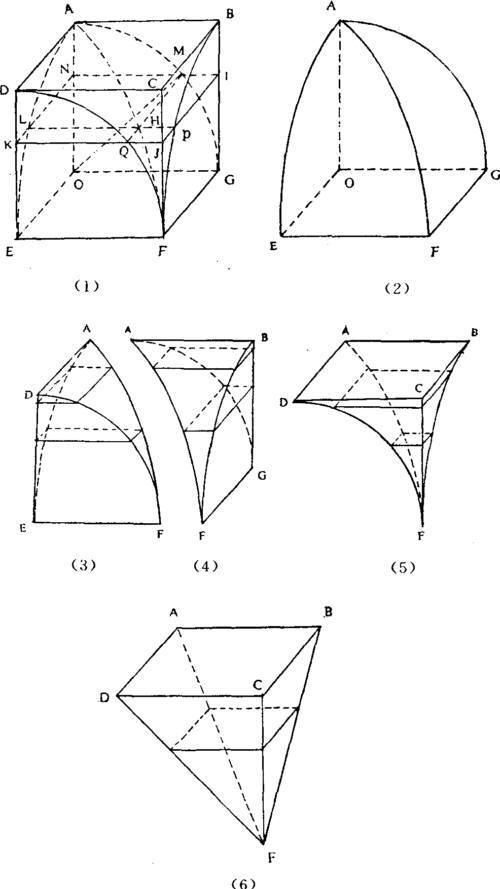Chapter 51 Section 5 The Principle of Zuo and the Volume of a Ball
Zuo's principle, which is called Cavalieri's principle in the West, means that two sets of solids of equal height, if their cross-sectional areas at equal heights are equal, their volumes must be equal.Zu Dingzhi summed it up in a very concise language: "Fu Die is established as a product, and since the power and potential are the same, the product cannot be different." ("Nine Chapters of Arithmetic Shaoguang Chapter Note") Ancient Chinese understood this principle and experienced long process.In "Nine Chapters of Arithmetic", cylinders and square columns, cones and square cones, round pavilions and square pavilions all appear in pairs, indicating that the volume of the former is deduced from the latter by comparing the base areas of the two. The rudimentary form of the principle of ancestors.Liu Hui realized that it is not only necessary to compare the bottom areas of two solids, but also to compare the cross-sectional areas at arbitrary equal heights.In addition to Liu Hui proving the volume formulas of cones and circular pavilions through this principle, there are two points worth noting.One is that when he proved the formula of envy and volume, he proposed that "there is no way to push this up, so the square cone and the Yang horse have the same reality." Each layer of the square cone with the same height as the Yangma is an equal square, so their volumes are equal.Liu Hui further proposed that if each layer of a solid is equally divided by a plane, then its volume is equally divided.Liu Hui thus solved the volume formulas of several different shapes of soft-shelled turtles, close to proposing that the volume of a tetrahedron of any shape is 1/6 of the base times the height.This realization is very important due to the key position of the turtle in polyhedron theory.The second is that he pointed out the error in the volume formula of the sphere contained in the "Nine Chapters" of Opening the Circle Technique, and the reason for the error is that the ratio of the volume of the sphere to the circumscribed cylinder is regarded as π:4.He designed a new solid: two equal cylinders are orthogonal, and their common part is called Mouhe square cover.Liu Hui pointed out that the ratio of the volume of the sphere to the circumscribed Mohe square cover is π:4.Obviously, only the volume of the Mouhe square cover is required, and the volume of the sphere can be readily solved.Liu Hui failed to find out the volume of Mouhe Fanggai, saying that "it should be the one who can speak".
The mathematician Liu Hui is looking forward to is the ancestor Dianzhi 200 years later.This work is likely to be the joint creation of Zu Dianzhi and his father.Zu Chongzhi said in "Refutation": "The old mistakes of Li Yuan, Zhang Heng explained and could not be corrected." It can be seen that he has studied the problem of the volume of the ball.On the basis of Liu Hui's work, Zu's father and son continued to consider using two equal cylinders circumscribed to the sphere to orthogonally divide the remaining part of the Mouhe square cover in a cube.Li Chunfeng et al.'s "Nine Chapters of Arithmetic Notes" recorded Zu Dianzhi's method as follows: consider 1/8 of the cube and the Mouhe square cover, that is, the small cube ABCDEFGO, as shown in Figure 39(1).According to Liu Hui's division method, 1/8 of the Mouhe square cover is AEFGO, which is called Neizhuo, as shown in Figure 39(2).The remaining part of the cube is divided into three parts at the same time: ADEF, ABGF, ABCDF, called the outer three parts, as shown in Figure 39 (3), (4), (5).Considering the cross-section NIJK at any point N on the height AO, its area is the square of the spherical radius r, which consists of four parts: the inner cross-section NMHL, the outer three cross-sections LHQK, MIPH, HPJQ.Suppose the cross-sectional area of the inner one is b, ON=a, then the sum of the cross-sectional areas of the three outer ones should be rb, and from the Pythagorean ONM, rb=a, and a is just equal to a length, width and height are r The Yangma distance from the apex is the cross-sectional area at a, as shown in Figure 39(6).According to Zu's principle, the sum of the outer three volumes is equal to the volume of the above-mentioned Yang horse, that is, (1/3)r, then the inner volume is (2/3)r, and the volume of the Mouhe square cover is (2/3)D .So the volume of the sphere V=1/4π·(2/3)D=(π/6)D, and finally the problem of the volume of the sphere is satisfactorily solved.If π=3, the volume of the sphere is 1/2D.Zu Dian's Kaili Yuanshu takes the latter.

Figure 39 The quadrature of Mouhe square cover

Figure 39 The quadrature of Mouhe square cover
